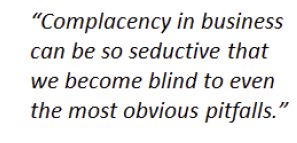Challenge Your Center Point to Create Exponential Growth
Click here to download “Challenge Your Center Point” (PDF) or read it below.
Embracing the discomfort of looking beyond your comfort zone can be the key to generating new business and growing wallet share.
An old adage goes that if you aren’t moving forward, you’re moving backward. You might be the best in your field with the most cutting edge processes today, but tomorrow is a new day. The landscape around you won’t stop evolving, and your competitors are hungry and motivated. They are willing to explore new opportunities and to take bigger risks if it means rising to the top.
They might be behind you now, but as soon as you stand still, they will ultimately pass you by.
We’ve seen this cycle time and time again in our industry. The hungry advisors see the opportunity around the corner, and their willingness to experiment and endure the growing pains of adopting something new gives them a significant advantage. For the forward-thinking advisors, the reset on January 1 is not a source of stress because their new business plan has already accounted for the next 12 months. They get to the opportunities first and build momentum long before the complacent advisors begrudgingly adapt their business model to account for the new standard.
In this white paper, we will explore how recent and coming industry shifts in new business development could be a boon for your business, provided that you approach these changes with a mindset geared toward aggressively pursuing growth.
A Story from the Recent Past: Mutual Funds and ETFs
Over the last decade, we saw this process playout with the rise of ETFs. When mutual funds first rose to prominence in the 1940s, they provided a stock market investment option for the smaller investor and in many cases were clearly the smarter investment when compared to traditional stock trading. The investment process was easier and so was diversification and liquidity. Furthermore, the lower barrier of entry gave forward-thinking advisors an opportunity to engage an entirely new pool of clients. These customers might not have had the capital to participate in traditional stock investments, but now with mutual funds they could find a return and do so with more safety at a modest price point.
And that meant more clients to manage and an opportunity for more wallet share.
In 1993, when ETFs first started to gain traction, a new generation of proactive advisors saw that ETFs offered selling points that were remarkably similar to mutual funds but were at the same more advantageous. For clients, the similar ease of management and the returns potentially higher due to lower fees. Surprisingly, we saw that many of the advisors that had at one point found success with mutual funds were slow to react to the ETF opportunity. The difference? Their practices were now established. They had a stable base of mutual fund clients. Maintaining the status quo felt easier and safer. That safety was comfortable, and that comfort in turn bred a sense of stubbornness and a fear of change.
It wasn’t long, however, until we saw clients begin to migrate away from mutual funds to ETFs.
 The advisors championing ETFs knew how to convey the value, and if clients weren’t with an advisor who was on the cutting edge, they would soon encounter one who was. Just as we saw with mutual funds, the early adopters captured new opportunities and established momentum while the “good ol’ days” mentality meant that many once successful advisors fell behind.
The advisors championing ETFs knew how to convey the value, and if clients weren’t with an advisor who was on the cutting edge, they would soon encounter one who was. Just as we saw with mutual funds, the early adopters captured new opportunities and established momentum while the “good ol’ days” mentality meant that many once successful advisors fell behind.
This story has happened before, and it will happen again. It will happen with services and products. It will happen with technology. And it will happen with marketing and new client acquisition.
Proactive vs. Reactive
In the broader sense of business, having to cope with emerging technology or changes in trends is nothing new. Not too long ago we saw the following changes transform nearly every industry in the world, ours included:
- The world wide web
- Outsourcing support and manufacturing
- Email marketing
- Social media
- Big data analysis
The proactive businesses looked to the horizon, saw the potential in the coming changes, and evolved their businesses accordingly. While the rise of the internet feels almost like ancient history now, the businesses that were savvy enough to go online early captured real estate and customers in what was then a new frontier. Those same businesses saw the potential of moving from direct mail to email, increasing engagement with customers while dramatically cutting costs. And all of the data that came with this shift led to a slew of marketing and customer service opportunities.
By the time the reactive businesses begrudgingly followed suit, they found themselves trying to learn and adopt new practices while their competitors were focused on getting even better. Sometimes this can feel like being the father asking his daughter to teach him how to Snapchat. The alternative to that initial awkwardness, however, is falling behind completely.
In sports terms—where the competitive nature makes the differences in mentality even more stark—the reactive businesses entered a game of basketball where they were just learning to dribble while their competitors were honing and developing new plays. The disparity in performance is glaringly obvious in a setting like basketball, but complacency in business can be so seductive that we become blind to even the most obvious pitfalls.
Moving Reactive to Proactive
 Leaving the familiarity of predictability of complacency behind can be uncomfortable, but the rewards are significant: growth that is potentially exponential. And these rewards are reserved for those who deal best with discomfort and ambiguity. When it comes to generating new business in the financial services and insurance industries, the market becomes more competitive with each passing day. The challenge becomes balancing the work required to run your business today while also thinking on and planning for a future that sometimes feel distant.
Leaving the familiarity of predictability of complacency behind can be uncomfortable, but the rewards are significant: growth that is potentially exponential. And these rewards are reserved for those who deal best with discomfort and ambiguity. When it comes to generating new business in the financial services and insurance industries, the market becomes more competitive with each passing day. The challenge becomes balancing the work required to run your business today while also thinking on and planning for a future that sometimes feel distant.
Here’s how to tackle it:
1. Engage likeminded business owners. Our industry is full of professional organizations that host conventions, seminars, and study groups and routinely share cutting edge content. While these are great opportunities to stay abreast of new developments and to interact with people like yourself, you should also look to form partnerships with businesses that understand the challenges of your industry and specialize in helping you to overcome them. An appointment setting firm, like The PT Services Group for example, can help you to see the opportunities on the horizon since that is their sole focus.
2. Think beyond referrals. Relying on referrals alone is a surefire sign that you are drifting into complacency. This puts your destiny in the hands of your clients. While referrals are undoubtedly a powerful source of new business, you shouldn’t leave behind the marketing mindset that helped you get to a stable base of clients in the first place. The competitor who has a stream of referrals and an active new business engine—seminars, appointment setting, drip marketing—will eventually overtake what word of mouth power and reputation you have by sheer volume alone. To stay competitive, you have to embrace the initiatives that might put you outside of your comfort zone.
3. Work with outside consultants. In today’s economy, finding a freelance marketing consultant to help you with your business is not difficult and can actually be quite affordable. This outside perspective allows you to build a team of specialists and frees you from having to be the expert on every facet of the business—your website, your email marketing, your social media, etc.—and gives you a clear process for staying ahead of the curve. The right consultant will do the leg work of gleaning insights from new trends for you so that you can focus on applying them to your business, with his or her help. This keeps your head in your business without letting you fall behind.
4. Be open to coaching. Don’t close the door on new knowledge because you believe you have mastered a skill or process. Working with consultants will require an open mind, and you should keep that open mind even when discussing pieces of your business that you have a high-degree of proficiency and competence in. For example, our CEO, Harvey Pollack, is open about the value he found in working with a CEO coach, and many of our clients talk about how much Sandler Sales Coaching helped them to grow their businesses. Even though most of our clients have worked in the industry for 20 years or more, we find that the most successful clients embrace the discomfort of the unknown and keep an open mind. They are willing to adjust their process to capture new and unique opportunities. Along the way they pick up tips and tricks that help them to stay abreast of general trends in sales strategy as well.
5. Regularly meet with new prospects. To uncover new opportunities and to create a steady stream of sales, you need to build mechanisms into your business that enable you to meet with completely new prospects on a regular basis. As competition grows and the caliber of your target client becomes more refined, the length of your sales process is likely to increase, meaning that it could take a year or more to close that one big client. To succeed in this environment, you need multiple irons in the fire simultaneously. And to be successful in first meetings, you must always have recent, relevant experience, making it essential that you keep your sales skills sharp. You could manage the leg work of forming alliances with CPAs and cold calling business owners in new markets yourself (like you did when you were just starting out), or you can hire an appointment setting firm to take on that work for you.
6. Build a consistent sales pipeline. The culmination of the above tips should lead to a sales pipeline that predictably creates opportunities for new businesses. Your efforts should have you meeting with new non-referred prospects month after month. These prospects should help you to strengthen your foothold in your current target market and also help you to expand your business into new markets as well. This pipeline, which includes everything from meetings with qualified prospects to an efficient and effective lead nurturing system, will make your growth sustainable and your profits predictable.
Conclusion
When I was young, my parents purchased their first VCR. They knew it was the thing to have, but they put it off getting one. Once most of the families on the block had got one, they finally caved in. They brought it home, pulled it out of the box, and stared blankly at this seemingly alien piece of technology. They looked at the cords and the connections and then looked at me.
“Do you know how this works?”
This memory has stuck with me, and I think about it whenever I am faced with a new industry or technological development. Is it uncomfortable when my daughter has to teach me how to use Snapchat? Well, yes. It’s hard not to feel a bit silly, but the rewards for that momentary discomfort are great. I get to learn something new, and I get to stay in touch with my daughter while she is off at college.
I don’t get left behind. The speed of change is ever-increasing, and we need to evolve. We have to accept that change is inevitable and that forcing ourselves to become uncomfortable will let us keep up with the curve and uncover new opportunities.
When it comes to your professional life, the exact path you take and business you build will depend on you, your style, and your target market, but these general tips should already have you thinking more proactively and less reactively. We are also happy to take a few minutes to talk through your business, your current challenges, and the new business opportunities that we see being the best for your business.
Good luck!
About John Pojeta—Vice President of Business Development
 John researches new types of business and manages and initiates strategic, corporate-level relationships to expand exposure for The PT Services Group. John came to The PT Services Group in 2011. Before that, he owned and operated an Ameriprise Financial Services franchise for 16 years.
John researches new types of business and manages and initiates strategic, corporate-level relationships to expand exposure for The PT Services Group. John came to The PT Services Group in 2011. Before that, he owned and operated an Ameriprise Financial Services franchise for 16 years.
Contact John by email at John@ThePTServicesGroup.com or by phone at 412-291-6685.
About The PT Services Group
 The PT Services Group is committed to helping you open the doors to new prospects and new business. While the methodology and expertise behind our appointment setting, business intelligence, and data collection programs are powerful tools, the secret to their effectiveness is the people using them. We are owned, operated, and staffed by professionals with expert knowledge of the financial services and insurance industries.
The PT Services Group is committed to helping you open the doors to new prospects and new business. While the methodology and expertise behind our appointment setting, business intelligence, and data collection programs are powerful tools, the secret to their effectiveness is the people using them. We are owned, operated, and staffed by professionals with expert knowledge of the financial services and insurance industries.